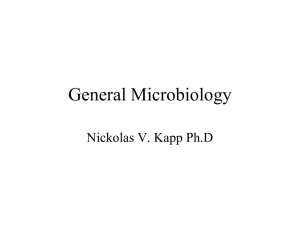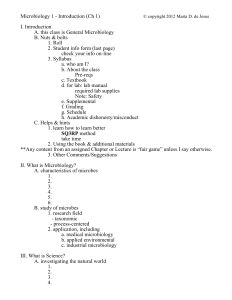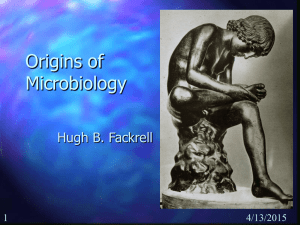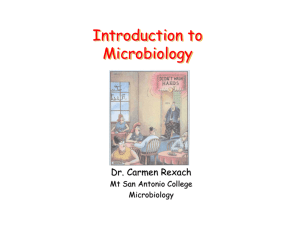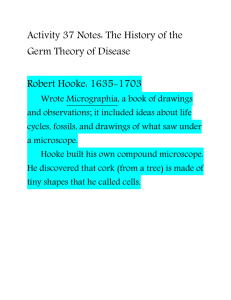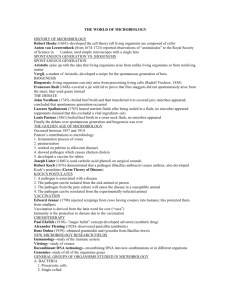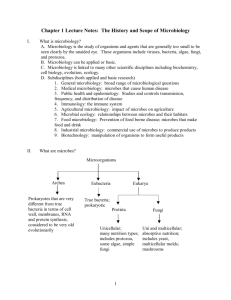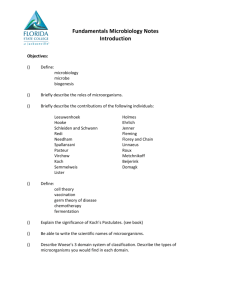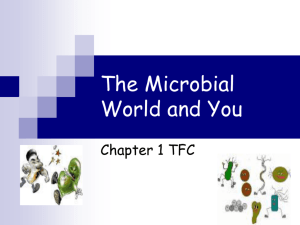General Microbiology
advertisement
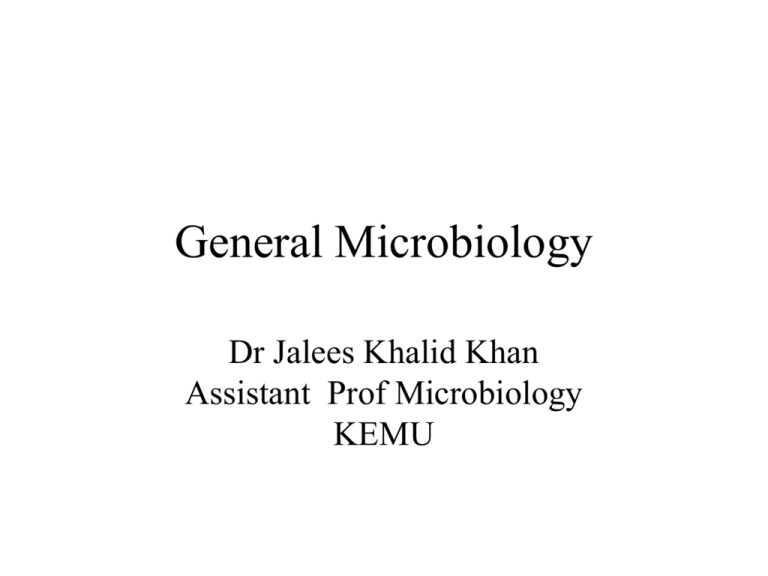
General Microbiology Dr Jalees Khalid Khan Assistant Prof Microbiology KEMU As you can see Sometimes there is a blur between what we do in lab and what we do in class. What is a Microbe • Smaller than 0.1mm • Includes bugs, things, germs, viruses, protozoan, bacteria, animalcules, small suckers Nomenclature • Carolus Linnaeus (1735) • Genus species • By custom once mentioned can be abbreviated with initial of genus followed by specific epithet. E. coli • When two organisms share a common genus are related. Why study Microbiology • Microbes are related to all life. – In all environments – Many beneficial aspects – Related to life processes (food web, nutrient cycling) – Only a minority are pathogenic. – Most of our problems are caused by microbes EID’s • Emerging infectious diseases – Weapons of mass destruction – New evolutionary features – Response to man encroaching on the environment • Can you name an example? Microbes in research • 10 trillion human cells 10x this number microbes • Easy to grow • Biochemistry is essentially the same • Simple and easy to study Biotechnology • Use of biological systems to produce useful items • The use of biological information to make things or improve the human condition Diversity of Microbes • Bacteria-single celled prokaryotes • Protozoa-eukaryotic, single celled, colonial, many ways of nutrition • Fungi- absorb nutrients, single celled filamentous • Viruses-acellular entities • Others- worms, insects Bacteria • Prokaryotes • Peptidoglycan cell walls • Binary fission • For energy, use organic chemicals, inorganic chemicals, or photosynthesis Figure 1.1a Archaea: • Prokaryotic • Lack peptidoglycan • Live in extreme environments • Include: – Methanogens – Extreme halophiles – Extreme thermophiles Halobacteria not from book • Eukaryotes • Chitin cell walls • Use organic chemicals for energy • Molds and mushrooms are multicellular consisting of masses of mycelia, which are composed of filaments called hyphae • Yeasts are unicellular Fungi Figure 1.1b Protozoa • Eukaryotes • Absorb or ingest organic chemicals • May be motile via pseudopods, cilia, or flagella • Most free some parasites Figure 1.1c Algae • Eukaryotes • Cellulose cell walls • Use photosynthesis for energy (primary producers) • Produce molecular oxygen and organic compounds • Metabolically diverse Figure 1.1d Viruses • Acellular • Consist of DNA or RNA core • Core is surrounded by a protein coat • Coat may be enclosed in a lipid envelope • Viruses are replicated only when they are in a living host cell Figure 1.1e Multicellular Animal Parasites • Eukaryote • Multicellular animals • Parasitic flatworms and round worms are called helminths. • Microscopic stages in life cycles. Figure fluke The Scientific Method • • • • • Make an observation Make a hypothesis Test the hypothesis Draw your conclusions repeat Requirements for Scientific methods • Single variables • Experimental controls • How can this be used to discover things? • Does HIV cause AIDS??? Discuss Knowledge of microorganisms: • Allows humans to – Prevent food spoilage – Prevent disease occurrence – Others? • Led to aseptic techniques to prevent contamination in medicine and in microbiology laboratories. Universal precautions set up by CDC • • • • • • • Use gloves, gowns, masks and goggles Minimize risk of needle sticks Disinfections procedure Preventative treatment after exposure Reduce risk Treat all patients the same HBV greater risk than HIV The Debate Over Spontaneous Generation • The hypothesis that living organisms arise from nonliving matter is called spontaneous generation. According to spontaneous generation, a “vital force’ forms life. • The Alternative hypothesis, that the living organisms arise from preexisting life, is called biogenesis. Evidence Pro and Con • 1668: Francisco Redi filled six jars with decaying meat. Conditions Results 3 jars covered with fine net 3 open jars No maggots Maggots appeared From where did the maggots come? What was the purpose of the sealed jars? Spontaneous generation or biogenesis? Evidence Pro and Con • 1765: Lazzaro Spallanzani boiled nutrient solutions in flasks. Conditions Results Nutrient broth placed in No microbial growth flask, heated, then sealed Spontaneous generation or biogenesis? The Theory of Biogenesis • Pasteur’s S-shaped flask kept microbes out but let air in. Figure 1.3 Where is Microbiology currently being practiced? I.e. jobs • Put your Choice here A timeline of Microbiology • Fig 1.4 • Some highlights – – – – – – 1665 Hooke 1673 van Leeuwenhoek’s microscopes 1735 Linnaeus Nomenclature 1798 Jenner vaccine 1857 Pasteur Fermentation 1876 Koch germ theory of disease The Golden Age of Microbiology • 1857-1914 • Beginning with Pasteur’s work, discoveries included the relationship between microbes and disease, immunity, and antimicrobial drugs Fermentation and Pasteurization • Pasteur showed that microbes are responsible for fermentation. • Fermentation is the conversation of sugar to alcohol to make beer and wine. • Microbial growth is also responsible for spoilage of food. • Bacteria that use alcohol and produce acetic acid spoil wine by turning it to vinegar (acetic acid). Fermentation and Pasteurization • Pasteur demonstrated that these spoilage bacteria could be killed by heat that was not hot enough to evaporate the alcohol in wine. This application of a high heat for a short time is called pasteurization. Figure 1.4 The Germ Theory of Disease • 1835: Agostino Bassi showed a silkworm disease was caused by a fungus. • 1865: Pasteur believed that another silkworm disease was caused by a protozoan. • 1840s: Ignaz Semmelwise advocated hand washing to prevent transmission of puerperal fever from one OB patient to another. The Germ Theory of Disease • 1860s: Joseph Lister used a chemical disinfectant to prevent surgical wound infections after looking at Pasteur’s work showing microbes are in the air, can spoil food, and cause animal diseases. • 1876: Robert Koch provided proof that a bacterium causes anthrax and provided the experimental steps, Koch’s postulates, used to prove that a specific microbe causes a specific disease. The Birth of Modern Chemotherapy • Treatment with chemicals is chemotherapy. • Chemotherapeutic agents used to treat infectious disease can be synthetic drugs or antibiotics. • Antibiotics are chemicals produced by bacteria and fungi that inhibit or kill other microbes. • Quinine from tree bark was long used to treat malaria. • 1910: Paul Ehrlich developed a synthetic arsenic drug, salvarsan, to treat syphilis. • 1930s: Sulfonamides were synthesized. The Birth of Modern Chemotherapy • 1928: Alexander Fleming discovered the first antibiotic. • He observed that Penicillium fungus made an antibiotic, penicillin, that killed S. aureus. • 1940s: Penicillin was tested clinically and mass produced. Similar to Figure 1.5 Modern Developments in Microbiology • Bacteriology is the study of bacteria. • Mycology is the study of fungi. • Parasitology is the study of protozoa and parasitic worms. • Recent advances in genomics, the study of an organism’s genes, have provided new tools for classifying microorganisms. • Proteomics is looking at the gene products Selected Novel Prizes in Physiology or Medicine von Behring Diphtheria antitoxin 1901* 1902 Ross Malaria transmission 1905 Koch TB bacterium 1908 Metchnikoff Phagocytes 1945 Fleming, Chain, Florey Penicillin 1952 Waksman Streptomycin 1969 Delbrück, Hershey, Luria Viral replication 1987 Tonegawa Antibody genetics 1997Prusiner Prions 2003Agre, Mackirron water and ion channels 2005 Marshall, Warren Helicobacter and ulcers 2008 Hausen Papilloma and viruses * The first Nobel Prize in Physiology or Medicine. Principles of Microscopy • Metric units (table 3.1) – Micrometer – Nanometer – angstrom Compound light microscopy • Basic parts – – – – – – – – Eyepieces (ocular lens) Base Condenser Iris diaphragm Objective lens Body tube Mechanical stage Adjustment knobs Magnification • Calculation: – Objective power x ocular power = total power • Parafocial • Paracentric • Microscopic measurement – Micrometer? Why must we calibrate it? Modern Developments in Microbiology • • • • Diagnostics Prevention Use as a tool Surveys and vigilance What you should know? • • • • • • • What are microbes? What types of microbes? Some history Highlights The Magic Bullet Microbes and human Welfare Microbes and Human Disease The CDC

